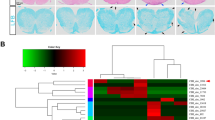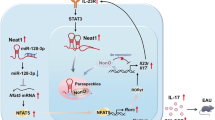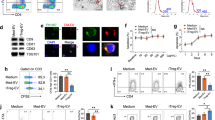Abstract
Inflammatory cytokines such as interleukin-17 (IL-17) promote inflammatory autoimmune diseases. Although several microRNAs (miRNAs) have been shown to regulate autoimmune pathogenesis by affecting lymphocyte development and function, the role of miRNAs in resident cells present in inflammatory lesions remains unclear. Here we show that miR-23b is downregulated in inflammatory lesions of humans with lupus or rheumatoid arthritis, as well as in the mouse models of lupus, rheumatoid arthritis or multiple sclerosis. IL-17 downregulates miR-23b expression in human fibroblast-like synoviocytes, mouse primary kidney cells and astrocytes and is essential for the downregulation of miR-23b during autoimmune pathogenesis. In turn, miR-23b suppresses IL-17−, tumor necrosis factor α (TNF-α)− or IL-1β–induced NF-κB activation and inflammatory cytokine expression by targeting TGF-β–activated kinase 1/MAP3K7 binding protein 2 (TAB2), TAB3 and inhibitor of nuclear factor κ-B kinase subunit α (IKK-α) and, consequently, represses autoimmune inflammation. Thus, IL-17 contributes to autoimmune pathogenesis by suppressing miR-23b expression in radio-resident cells and promoting proinflammatory cytokine expression.
This is a preview of subscription content, access via your institution
Access options
Subscribe to this journal
Receive 12 print issues and online access
$209.00 per year
only $17.42 per issue
Buy this article
- Purchase on Springer Link
- Instant access to full article PDF
Prices may be subject to local taxes which are calculated during checkout






Similar content being viewed by others
Accession codes
References
Firestein, G.S. Evolving concepts of rheumatoid arthritis. Nature 423, 356–361 (2003).
Compston, A. & Coles, A. Multiple sclerosis. Lancet 372, 1502–1517 (2008).
Rahman, A. & Isenberg, D.A. Systemic lupus erythematosus. N. Engl. J. Med. 358, 929–939 (2008).
Zhu, S. & Qian, Y. IL-17/IL-17 receptor system in autoimmune disease: mechanisms and therapeutic potential. Clin. Sci. (Lond.) 122, 487–511 (2012).
Feldmann, M., Brennan, F.M. & Maini, R.N. Role of cytokines in rheumatoid arthritis. Annu. Rev. Immunol. 14, 397–440 (1996).
Smolen, J.S., Steiner, G. & Aringer, M. Anti-cytokine therapy in systemic lupus erythematosus. Lupus 14, 189–191 (2005).
Sospedra, M. & Martin, R. Immunology of multiple sclerosis. Annu. Rev. Immunol. 23, 683–747 (2005).
Williams, R.O., Paleolog, E. & Feldmann, M. Cytokine inhibitors in rheumatoid arthritis and other autoimmune diseases. Curr. Opin. Pharmacol. 7, 412–417 (2007).
Hueber, W. et al. Effects of AIN457, a fully human antibody to interleukin-17A, on psoriasis, rheumatoid arthritis, and uveitis. Sci. Transl. Med. 2, 52ra72 (2010).
Lipsky, P.E. et al. Infliximab and methotrexate in the treatment of rheumatoid arthritis. Anti-Tumor Necrosis Factor Trial in Rheumatoid Arthritis with Concomitant Therapy Study Group. N. Engl. J. Med. 343, 1594–1602 (2000).
Geyer, M. & Muller-Ladner, U. Actual status of antiinterleukin-1 therapies in rheumatic diseases. Curr. Opin. Rheumatol. 22, 246–251 (2010).
Genovese, M.C. et al. LY2439821, a humanized anti–interleukin-17 monoclonal antibody, in the treatment of patients with rheumatoid arthritis: a phase I randomized, double-blind, placebo-controlled, proof-of-concept study. Arthritis Rheum. 62, 929–939 (2010).
Lu, L.F. et al. Function of miR-146a in controlling Treg cell–mediated regulation of Th1 responses. Cell 142, 914–929 (2010).
O'Connell, R.M. et al. MicroRNA-155 promotes autoimmune inflammation by enhancing inflammatory T cell development. Immunity 33, 607–619 (2010).
Du, C. et al. MicroRNA miR-326 regulates TH-17 differentiation and is associated with the pathogenesis of multiple sclerosis. Nat. Immunol. 10, 1252–1259 (2009).
Stittrich, A.B. et al. The microRNA miR-182 is induced by IL-2 and promotes clonal expansion of activated helper T lymphocytes. Nat. Immunol. 11, 1057–1062 (2010).
Xiao, C. et al. MiR-150 controls B cell differentiation by targeting the transcription factor c-Myb. Cell 131, 146–159 (2007).
Rodriguez, A. et al. Requirement of bic/microRNA-155 for normal immune function. Science 316, 608–611 (2007).
Thai, T.H. et al. Regulation of the germinal center response by microRNA-155. Science 316, 604–608 (2007).
Johnnidis, J.B. et al. Regulation of progenitor cell proliferation and granulocyte function by microRNA-223. Nature 451, 1125–1129 (2008).
Lu, L.F. et al. Foxp3-dependent microRNA155 confers competitive fitness to regulatory T cells by targeting SOCS1 protein. Immunity 30, 80–91 (2009).
Xiao, C. et al. Lymphoproliferative disease and autoimmunity in mice with increased miR-17–92 expression in lymphocytes. Nat. Immunol. 9, 405–414 (2008).
Ponomarev, E.D., Veremeyko, T., Barteneva, N., Krichevsky, A.M. & Weiner, H.L. MicroRNA-124 promotes microglia quiescence and suppresses EAE by deactivating macrophages via the C/EBP-α-PU.1 pathway. Nat. Med. 17, 64–70 (2011).
O'Connell, R.M., Rao, D.S., Chaudhuri, A.A. & Baltimore, D. Physiological and pathological roles for microRNAs in the immune system. Nat. Rev. Immunol. 10, 111–122 (2010).
Nakamachi, Y. et al. MicroRNA-124a is a key regulator of proliferation and monocyte chemoattractant protein 1 secretion in fibroblast-like synoviocytes from patients with rheumatoid arthritis. Arthritis Rheum. 60, 1294–1304 (2009).
Junker, A. et al. MicroRNA profiling of multiple sclerosis lesions identifies modulators of the regulatory protein CD47. Brain 132, 3342–3352 (2009).
Dai, Y. et al. Comprehensive analysis of microRNA expression patterns in renal biopsies of lupus nephritis patients. Rheumatol. Int. 29, 749–754 (2009).
Pan, W. et al. MicroRNA-21 and microRNA-148a contribute to DNA hypomethylation in lupus CD4+ T cells by directly and indirectly targeting DNA methyltransferase 1. J. Immunol. 184, 6773–6781 (2010).
Li, J. et al. Altered microRNA expression profile with miR-146a upregulation in CD4+ T cells from patients with rheumatoid arthritis. Arthritis Res. Ther. 12, R81 (2010).
De Santis, G. et al. Altered miRNA expression in T regulatory cells in course of multiple sclerosis. J. Neuroimmunol. 226, 165–171 (2010).
Tili, E. et al. Modulation of miR-155 and miR-125b levels following lipopolysaccharide/TNF-α stimulation and their possible roles in regulating the response to endotoxin shock. J. Immunol. 179, 5082–5089 (2007).
Taganov, K.D., Boldin, M.P., Chang, K.J. & Baltimore, D. NF-κB-dependent induction of microRNA miR-146, an inhibitor targeted to signaling proteins of innate immune responses. Proc. Natl. Acad. Sci. USA 103, 12481–12486 (2006).
Chang, S.H., Park, H. & Dong, C. Act1 adaptor protein is an immediate and essential signaling component of interleukin-17 receptor. J. Biol. Chem. 281, 35603–35607 (2006).
Sønder, S.U. et al. IL-17-induced NF-κB activation via CIKS/Act1: physiologic significance and signaling mechanisms. J. Biol. Chem. 286, 12881–12890 (2011).
Qian, Y. et al. The adaptor Act1 is required for interleukin 17-dependent signaling associated with autoimmune and inflammatory disease. Nat. Immunol. 8, 247–256 (2007).
Ma, F. et al. The microRNA miR-29 controls innate and adaptive immune responses to intracellular bacterial infection by targeting interferon-γ. Nat. Immunol. 12, 861–869 (2011).
Rodriguez, A., Griffiths-Jones, S., Ashurst, J.L. & Bradley, A. Identification of mammalian microRNA host genes and transcription units. Genome Res. 14, 1902–1910 (2004).
Yamamoto, M. et al. Regulation of Toll/IL-1-receptor-mediated gene expression by the inducible nuclear protein I(Bζ. Nature 430, 218–222 (2004).
Shen, F., Ruddy, M.J., Plamondon, P. & Gaffen, S.L. Cytokines link osteoblasts and inflammation: microarray analysis of interleukin-17– and TNF-α–induced genes in bone cells. J. Leukoc. Biol. 77, 388–399 (2005).
Kao, C.Y., Kim, C., Huang, F. & Wu, R. Requirements for two proximal NF-κB binding sites and IκB-ζ in IL-17A–induced human β-defensin 2 expression by conducting airway epithelium. J. Biol. Chem. 283, 15309–15318 (2008).
Rossi, R.L. et al. Distinct microRNA signatures in human lymphocyte subsets and enforcement of the naive state in CD4+ T cells by the microRNA miR-125b. Nat. Immunol. 12, 796–803 (2011).
Ishitani, T. et al. Role of the TAB2-related protein TAB3 in IL-1 and TNF signaling. EMBO J. 22, 6277–6288 (2003).
Qian, Y., Kang, Z., Liu, C. & Li, X. IL-17 signaling in host defense and inflammatory diseases. Cell. Mol. Immunol. 7, 328–333 (2010).
Onishi, R.M. & Gaffen, S.L. Interleukin-17 and its target genes: mechanisms of interleukin-17 function in disease. Immunology 129, 311–321 (2010).
Iwakura, Y., Ishigame, H., Saijo, S. & Nakae, S. Functional specialization of interleukin-17 family members. Immunity 34, 149–162 (2011).
Hartupee, J. et al. IL-17 signaling for mRNA stabilization does not require TNF receptor–associated factor 6. J. Immunol. 182, 1660–1666 (2009).
Bulek, K. et al. The inducible kinase IKKi is required for IL-17–dependent signaling associated with neutrophilia and pulmonary inflammation. Nat. Immunol. 12, 844–852 (2011).
Sun, D. et al. Treatment with IL-17 prolongs the half-life of chemokine CXCL1 mRNA via the adaptor TRAF5 and the splicing-regulatory factor SF2 (ASF). Nat. Immunol. 12, 853–860 (2011).
Nakasa, T. et al. Expression of microRNA-146 in rheumatoid arthritis synovial tissue. Arthritis Rheum. 58, 1284–1292 (2008).
Zhang, H. et al. Genome-wide functional screening of miR-23b as a pleiotropic modulator suppressing cancer metastasis. Nat. Commun. 2, 554 (2011).
Gao, P. et al. c-Myc suppression of miR-23a/b enhances mitochondrial glutaminase expression and glutamine metabolism. Nature 458, 762–765 (2009).
Zhu, S. et al. Modulation of experimental autoimmune encephalomyelitis through TRAF3-mediated suppression of interleukin 17 receptor signaling. J. Exp. Med. 207, 2647–2662 (2010).
Kanayama, A. et al. TAB2 and TAB3 activate the NF-κB pathway through binding to polyubiquitin chains. Mol. Cell 15, 535–548 (2004).
Liu, C. et al. Act1, a U-box E3 ubiquitin ligase for IL-17 signaling. Sci. Signal. 2, ra63 (2009).
Shen, F. et al. IL-17 receptor signaling inhibits C/EBPβ by sequential phosphorylation of the regulatory 2 domain. Sci. Signal. 2, ra8 (2009).
Shi, P. et al. Persistent stimulation with interleukin-17 desensitizes cells through SCFβ-TrCP–mediated degradation of Act1. Sci. Signal. 4, ra73 (2011).
Austin, H.A. III., Muenz, L.R., Joyce, K.M., Antonovych, T.T. & Balow, J.E. Diffuse proliferative lupus nephritis: identification of specific pathologic features affecting renal outcome. Kidney Int. 25, 689–695 (1984).
Moreth, K. et al. The proteoglycan biglycan regulates expression of the B cell chemoattractant CXCL13 and aggravates murine lupus nephritis. J. Clin. Invest. 120, 4251–4272 (2010).
Acknowledgements
We thank R. Flavell (Yale University) for providing Il17a-deficient mice. This work is supported by grants from National Natural Science Foundation of China and 973 program (30930084, 2010CB529705, 91029708 and 30871298), Chinese Academy of Sciences (KSCX2-YW-R-146) and the Science and Technology Commission of Shanghai Municipality (10JC1416600) to Y.Q.; as well as National Natural Science Foundation of China (30971632 and 81025016), Chinese Ministry of Health (201202008) and the Program of the Shanghai Commission of Science and Technology (10JC1409300) to N.S.
Author information
Authors and Affiliations
Contributions
S.Z. and Y.Q. designed the experiments and wrote the manuscript. S.Z. and W.P. conducted most of the experiments and analyzed the data. W.P., N.S. and J.B.H. edited the manuscript. X. Song and Y.L. helped with mouse experiments. X. Shao helped with molecular cloning. Y.S., Y.T. and D.L. provided technical support. H.W. provided Il17a−/− mice. W.L. performed Ingenuity Pathway Analyses. N.S. and D.H. provided clinical samples. Y.Q. and N.S. supervised the study.
Corresponding authors
Ethics declarations
Competing interests
The authors declare no competing financial interests.
Supplementary information
Supplementary Text and Figures
Supplementary Figures 1–20, Supplementary Tables 1–5 and Supplementary Methods (PDF 2915 kb)
Rights and permissions
About this article
Cite this article
Zhu, S., Pan, W., Song, X. et al. The microRNA miR-23b suppresses IL-17-associated autoimmune inflammation by targeting TAB2, TAB3 and IKK-α. Nat Med 18, 1077–1086 (2012). https://doi.org/10.1038/nm.2815
Received:
Accepted:
Published:
Issue Date:
DOI: https://doi.org/10.1038/nm.2815
This article is cited by
-
The IL-17 family in diseases: from bench to bedside
Signal Transduction and Targeted Therapy (2023)
-
RBP–RNA interactions in the control of autoimmunity and autoinflammation
Cell Research (2023)
-
Fluorinated polyamidoamine dendrimer-mediated miR-23b delivery for the treatment of experimental rheumatoid arthritis in rats
Nature Communications (2023)
-
Hsa_circ_0021727 (circ-CD44) promotes ESCC progression by targeting miR-23b-5p to activate the TAB1/NFκB pathway
Cell Death & Disease (2023)
-
MicroRNAs-mediated regulation pathways in rheumatic diseases
Inflammopharmacology (2023)



